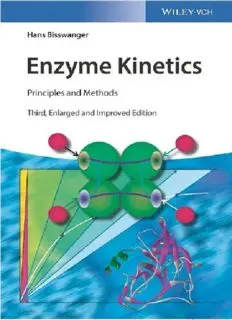
Enzyme Kinetics: Principles and Methods PDF
Preview Enzyme Kinetics: Principles and Methods
EnzymeKinetics Enzyme Kinetics PrinciplesandMethods HansBisswanger Third,enlargedandimprovedEdition Author AllbookspublishedbyWiley-VCHare carefullyproduced.Nevertheless,authors, Prof.Dr.HansBisswanger editors,andpublisherdonotwarrantthe Masurenweg8 informationcontainedinthesebooks, 72379Hechingen includingthisbook,tobefreeoferrors. Germany Readersareadvisedtokeepinmindthat statements,data,illustrations,procedural detailsorotheritemsmayinadvertently Cover beinaccurate. Thefiguresforthefrontcoverwere kindlyprovidedbytheauthor. LibraryofCongressCardNo.:appliedfor BritishLibraryCataloguing-in-Publication Data Acataloguerecordforthisbookis availablefromtheBritishLibrary. Bibliographicinformationpublishedby theDeutscheNationalbibliothek TheDeutscheNationalbibliothekliststhis publicationintheDeutscheNation- albibliografie;detailedbibliographic dataareavailableontheInternetat <http://dnb.d-nb.de>. ©2017Wiley-VCHVerlagGmbH&Co. KGaA,Boschstr.12,69469Weinheim, Germany Allrightsreserved(includingthoseof translationintootherlanguages).No partofthisbookmaybereproducedin anyform–byphotoprinting,microfilm, oranyothermeans–nortransmitted ortranslatedintoamachinelanguage withoutwrittenpermissionfromthe publishers.Registerednames,trademarks, etc.usedinthisbook,evenwhennot specificallymarkedassuch,arenottobe consideredunprotectedbylaw. PrintISBN:978-3-527-34251-8 ePDFISBN:978-3-527-80647-8 ePubISBN:978-3-527-80649-2 MobiISBN:978-3-527-80648-5 oBookISBN:978-3-527-80646-1 CoverDesign SchulzGrafik-Design, Fußgönheim,Germany Typesetting SPiGlobal,Chennai,India PrintingandBinding Printedonacid-freepaper v Contents Preface xi SymbolsandAbbreviations xiii IntroductionandDefinitions xv 1 MultipleEquilibria,Principles,andDerivations 1 1.1 GeneralConsiderations 1 1.2 Diffusion 2 1.3 ModesofLigandBinding 4 1.4 InteractionbetweenMacromoleculesandLigands 6 1.4.1 BindingConstants 6 1.4.2 BindingtoaSingleSite 7 1.5 BindingtoIdenticalIndependentSites 7 1.5.1 GeneralBindingEquation 7 1.5.2 GraphicRepresentationsoftheBindingEquation 13 1.5.2.1 DirectandLinearDiagrams 13 1.5.2.2 AnalysisofBindingDatafromSpectroscopicTitrations 15 1.5.3 BindingofDifferentLigands,Competition 18 1.5.4 NoncompetitiveBinding 21 1.6 BindingtoNonidentical,IndependentSites 23 References 25 2 CooperativityandAllostericEnzymes 27 2.1 BindingtoInteractingSites 27 2.1.1 TheHillEquation 27 2.1.2 TheAdairEquation 29 2.1.3 ThePaulingModel 32 2.2 AllostericEnzymes 32 2.2.1 TheSymmetryorConcertedModel 33 2.2.2 TheSequentialModelandNegativeCooperativity 38 2.2.3 AnalysisofCooperativity 42 2.2.4 PhysiologicalAspectsofCooperativity 44 vi Contents 2.2.5 ExamplesofAllostericEnzymes 46 2.2.5.1 Hemoglobin 46 2.2.5.2 AspartateTranscarbamoylase 48 2.2.5.3 Aspartokinase 49 2.2.5.4 Phosphofructokinase 50 2.2.5.5 AllostericRegulationoftheGlycogenMetabolism 50 2.2.5.6 Membrane-BoundEnzymesandReceptors 50 2.3 BindingtoNonidentical,InteractingSites 51 References 52 3 FromReactionOrdertotheMichaelis–MentenLaw: FundamentalRelationshipsofEnzymeKinetics 55 3.1 ReactionOrder 55 3.1.1 First-OrderReactions 56 3.1.2 Second-OrderReactions 57 3.1.3 Zero-OrderReactions 58 3.2 Steady-StateKineticsandtheMichaelis–MentenEquation 58 3.2.1 DerivationoftheMichaelis–MentenEquation 58 3.3 AnalysisofEnzymeKineticData 62 3.3.1 GraphicRepresentationsoftheMichaelis–MentenEquation 62 3.3.1.1 DirectandSemilogarithmicRepresentations 62 3.3.1.2 DirectLinearPlots 68 3.3.1.3 LinearizationMethods 70 3.3.2 AnalysisofProgressCurves 72 3.3.2.1 IntegratedMichaelis–MentenEquation 73 3.3.2.2 DeterminationofReactionRates 75 3.3.2.3 GraphicMethodsforRateDetermination 77 3.3.2.4 GraphicDeterminationofTrueInitialRates 79 3.4 ReversibleEnzymeReactions 80 3.4.1 RateEquationforReversibleEnzymeReactions 80 3.4.2 ProductInhibition 82 3.4.3 TheHaldaneRelationship 84 References 85 4 EnzymeInhibitionandRelatedMechanisms 87 4.1 UnspecificandIrreversibleInhibition 87 4.1.1 UnspecificInhibition 87 4.1.2 IrreversibleInhibition 88 4.1.2.1 GeneralFeaturesofIrreversibleInhibition 88 4.1.2.2 SuicideSubstrates 90 4.1.2.3 Transition-StateAnalogs 91 4.1.2.4 AnalysisofIrreversibleInhibition 92 4.2 ReversibleInhibition 94 4.2.1 GeneralRateEquation 94 Contents vii 4.2.1.1 NoncompetitiveInhibitionandGraphicRepresentationofInhibition Data 97 4.2.1.2 CompetitiveInhibition 102 4.2.1.3 UncompetitiveInhibition 106 4.2.2 PartialInhibitions 108 4.2.2.1 PartiallyNoncompetitiveInhibition 108 4.2.2.2 PartiallyUncompetitiveInhibition 110 4.2.2.3 PartiallyCompetitiveInhibition 111 4.2.3 NoncompetitiveandUncompetitiveProductInhibition 113 4.2.4 SubstrateInhibition 114 4.3 EnzymeReactionswithTwoCompetingSubstrates 116 4.4 DifferentEnzymesCatalyzingtheSameReaction 118 References 119 5 Multi-SubstrateReactions 121 5.1 Nomenclature 121 5.2 Multi-SubstrateMechanisms 122 5.2.1 RandomMechanism 122 5.2.2 OrderedMechanism 127 5.2.3 Ping-PongMechanism 129 5.2.4 ProductInhibitioninMulti-SubstrateReactions 131 5.2.5 HaldaneRelationshipsinMulti-SubstrateReactions 132 5.2.6 MechanismswithMoreThanTwoSubstrates 133 5.2.7 OtherNomenclaturesforMulti-SubstrateReactions 134 5.3 DerivationofRateEquationsofComplexEnzyme Mechanisms 135 5.3.1 King–AltmannMethod 135 5.3.2 SimplifiedDerivationsApplyingGraphTheory 140 5.3.3 CombinationofEquilibriumandSteady-StateApproach 141 References 143 6 pHandTemperatureDependenceofEnzymes 145 6.1 pHOptimumandDeterminationofpK Values 145 6.2 pHStability 147 6.3 TemperatureDependence 148 References 152 7 SpecialEnzymeMechanisms 153 7.1 KineticTreatmentofAllostericEnzymes 153 7.2 HystereticEnzymes 154 7.3 KineticCooperativity,theSlowTransitionModel 155 7.4 Ribozymes 156 7.5 EnzymesReactingwithPolymericSubstrates 159 References 160 viii Contents 8 EnzymesBoundtoArtificialMatricesandtoMembranes 163 8.1 ImmobilizedEnzymes 163 8.1.1 KineticsofImmobilizedEnzymes 163 8.1.2 ExternalDiffusionLimitation 165 8.1.3 InternalDiffusionLimitation 166 8.1.4 InhibitionofImmobilizedEnzymes 168 8.1.5 pHandTemperatureBehaviorofImmobilizedEnzymes 169 8.2 EnzymeReactionsattheMembrane 169 8.2.1 TransportProcesses 169 8.2.2 EnzymeReactionsatMembraneInterfaces 172 References 175 9 IsotopeExchangeandIsotopeEffects 177 9.1 IsotopeExchange 177 9.1.1 IsotopeExchangeKinetics 177 9.2 IsotopeEffects 181 9.2.1 PrimaryKineticIsotopeEffect 181 9.2.2 InfluenceoftheKineticIsotopeEffectonV andK 182 m 9.2.3 OtherIsotopeEffects 183 References 184 10 RelatedSubjectAreas 185 10.1 RelationshipbetweenEnzymeKineticsandPharmacokinetics 185 10.2 ApplicationofStatisticalMethodsinEnzymeKinetics 189 10.2.1 GeneralRemarks 189 10.2.2 StatisticalTermsUsedinEnzymeKinetics 191 References 193 11 MethodsfortheStudyofMultipleEquilibria 195 11.1 GeneralAspects 195 11.2 EquilibriumDialysisasanExampleforthePerformanceofBinding Measurements 197 11.2.1 PrincipleofEquilibriumDialysis 197 11.2.2 ControlExperimentsandSourcesofError 200 11.2.2.1 DialysisTime 200 11.2.2.2 ConcentrationandActivityoftheMacromolecule 200 11.2.2.3 ConcentrationoftheLigand 201 11.2.2.4 DonnanEffect 202 11.2.3 ContinuousEquilibriumDialysis 203 11.3 Ultrafiltration 206 11.4 GelFiltration 208 11.4.1 BatchMethod 208 11.4.2 TheMethodofHummelandDreyer 209 11.4.3 OtherGelFiltrationMethods 210 11.5 Ultracentrifugation 212 11.5.1 Fixed-AngleUltracentrifugationMethods 212 Contents ix 11.5.2 Sucrose-GradientCentrifugation 215 11.6 SurfacePlasmonResonance 218 References 220 12 Manometric,Electrochemical,andCalorimetricMethods 223 12.1 Warburg’sManometricApparatus 223 12.2 ElectrochemicalMethods 224 12.2.1 TheOxygenElectrode 224 12.2.2 TheCO Electrode 226 2 12.2.3 Potentiometry,RedoxPotentials 227 12.2.4 ThepH-Stat 227 12.2.5 Polarography 229 12.3 Calorimetry 230 References 232 13 AbsorptionandFluorescenceSpectroscopy 235 13.1 GeneralAspects 235 13.2 AbsorptionSpectroscopy 237 13.2.1 TheLambert–BeerLaw 237 13.2.2 SpectralPropertiesofEnzymesandLigands 238 13.2.3 StructureofSpectrophotometers 241 13.2.4 Double-BeamSpectrophotometer 245 13.2.5 DifferenceSpectroscopy 246 13.2.6 TheDual-WavelengthSpectrophotometer 249 13.3 PhotochemicalActionSpectra 250 13.4 Bioluminescence 251 13.5 FluorescenceSpectroscopy 251 13.5.1 QuantumYield 251 13.5.2 StructureofSpectrofluorometers 252 13.5.3 PerturbationsofFluorescenceMeasurements 254 13.5.4 FluorescentCompounds(Fluorophores) 255 13.5.5 RadiationlessEnergyTransfer 260 13.5.6 FluorescencePolarization 262 13.5.7 PulseFluorometry 263 13.5.8 FluorescenceCorrelationSpectroscopy 265 References 265 14 OtherSpectroscopicMethods 269 14.1 CircularDichroismandOpticalRotationDispersion 269 14.2 InfraredandRamanSpectroscopy 274 14.2.1 IRSpectroscopy 274 14.2.2 RamanSpectroscopy 275 14.2.3 Applications 275 14.3 NuclearMagneticResonanceSpectroscopy 276 14.4 ElectronParamagneticResonanceSpectroscopy 279 References 281
